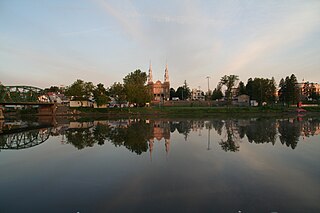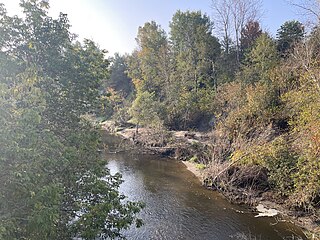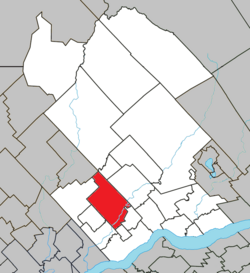
Deschambault-Grondines is a municipality located in the Portneuf Regional County Municipality (RCM), in the Capitale-Nationale region, Quebec, Canada.

Mékinac is a regional county municipality (RCM) of 5,607 km2 located in the administrative region of Mauricie, along the Saint-Maurice River, which also crosses the RCM from one end to the other, and the Matawin River, a tributary of the Saint-Maurice. Located in the province of Quebec, Canada.

Les Chenaux is a regional county municipality in central Quebec, Canada, in the Mauricie region. The seat is in Saint-Luc-de-Vincennes. It is located adjacent on the east of Trois-Rivières on the Saint Lawrence River. It has a land area of 872.04 square kilometres (336.70 sq mi) and a population of 17,865 inhabitants in the Canada 2011 Census. Its largest community is the parish of Notre-Dame-du-Mont-Carmel.

Saint-Casimir is a municipality located in Les Chenaux RCM, Mauricie region, Quebec, Canada.

Route 354 is an east-west regional road in Quebec, Canada, starting from Route 159 north of Ste-Anne de la Pérade going to St-Raymond. It follows the Rivière Ste-Anne on the south shore most of the time. It is 55 km long, and overlaps Route 363 about 4 km in St-Casimir. Between St-Casimir and Ste-Anne-de-la-Pérade, it is named the "Rapide Nord", where it is the only part it is on the north shore of the river. It becomes rue Tessier Ouest in the village zone. This section was really bad until fall 2005, when it was newly paved on 12 km. Once it crosses the Rivière Ste-Anne, in the village of St-Casimir, it takes the name of rue (street) Notre-Dame.

Sainte-Anne River, Teyaiar River, rivière Sainte-Anne (French), flows from north to south on the north shore in the estuary section of the St. Lawrence River, in Les Chenaux, Portneuf and La Jacques-Cartier RCM, Mauricie and National Capital regions, Quebec, Canada.

Sainte-Anne-de-la-Pérade is a municipality, located near the mouth of the Sainte-Anne River, on the north shore of the St. Lawrence River, Les Chenaux RCM, in Mauricie region, Quebec, Canada.

Saint-Prosper-de-Champlain is a municipality of 482 people in the Les Chenaux Regional County Municipality, in Quebec, Canada. It is the smallest municipality in terms of population in the regional county.

Saint-Stanislas, old name Deux-Rivières (Village), is a municipality part of Les Chenaux Regional County Municipality, in Mauricie, Quebec, Canada.

Sainte-Christine-d'Auvergne (Municipality), formerly Sainte-Catherine, is located along the banks of the Sainte-Anne River, in the Capitale-Nationale region, Portneuf RCM, Quebec, Canada.

Saint-Ubalde is a rural municipality in Portneuf County in the Canadian province of Quebec.
The Lordship of Sainte-Anne-de-la-Pérade was located on the north shore of St. Lawrence river, between Trois-Rivières and Quebec City in the province of Quebec, Canada. The southern front of the manor was on the edge of St. Lawrence river. The depth of the lordship was heading north, parallel to the Lordship of Batiscan. The northern boundary of the Lordship of Sainte-Anne-de-la-Perade stopped at the north-western boundary of St. Joseph row, in Sainte-Thècle. In comparison, the lordship of Batiscan spanned 20 "lieues", beyond the Saint-Maurice River. The western boundary of the manor cut the Batiscan river at the rapids of Manitou, between Saint-Adelphe and Saint-Stanislas. The estates of the north shore of St. Lawrence river fell within the stately administrative division of Trois-Rivières.

The Charest River originates from Charest Lake in the Montauban-les-Mines area, located in the eastern part of Notre-Dame-de-Montauban, within the Mekinac Regional County Municipality, in the administrative region of Mauricie in the province of Quebec, Canada. It flows southward, passing through several regions and receiving water from lakes such as Mine, Perron, Perreault, and End in its upper course.
The Zec Batiscan-Neilson is a "zone d'exploitation contrôlée", located in the unorganized territory of Lac-Blanc, in Portneuf Regional County Municipality, in the administrative area of the Capitale-Nationale, on the north shore of St. Lawrence River, in Quebec, Canada.

Noire River, Rivière Noire (French) is one of the main watercourses of the Sainte-Anne River watershed, it measures 62 km in length, its watershed has an area of 568 km².

Lake Montauban is located in the municipalities of Rivière-à-Pierre and Saint-Alban, Portneuf RCM, Capitale-Nationale, Quebec, Canada.

The Blanche River (St-Casimir) is a stream flowing in the municipalities of Saint-Ubalde, Saint-Thuribe, Saint-Alban and Saint-Casimir, in Portneuf RCM, Capitale-Nationale, Quebec, Canada.

The Weller River (Stream) is a tributary left bank of the Blanche River (St-Casimir) whose confluence is found east of the municipality of Saint-Ubalde, in the Portneuf Regional County Municipality, in the administrative region of Capitale-Nationale, in the province of Quebec in Canada.

Long Lake, Lac Long (French), is entirely located in Saint-Alban (Municipality), Portneuf RCM, Capitale-Nationale, Quebec, Canada.

Lake Clair (Sainte-Christine-d'Auvergne), Lac Clair (French) is located in the municipalities of Saint-Alban and Sainte-Christine-d’Auvergne, Portneuf RCM, Capitale-Nationale, Quebec, Canada.



























